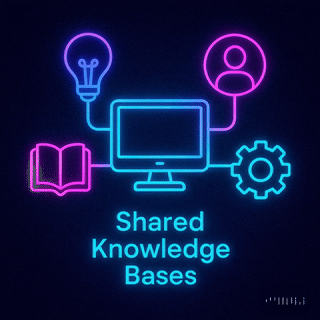
Tenant Data Isolation: Patterns and Anti-Patterns
Explore effective patterns and pitfalls of tenant data isolation in multi-tenant systems to enhance security and compliance.
Jul 30, 2025
Read More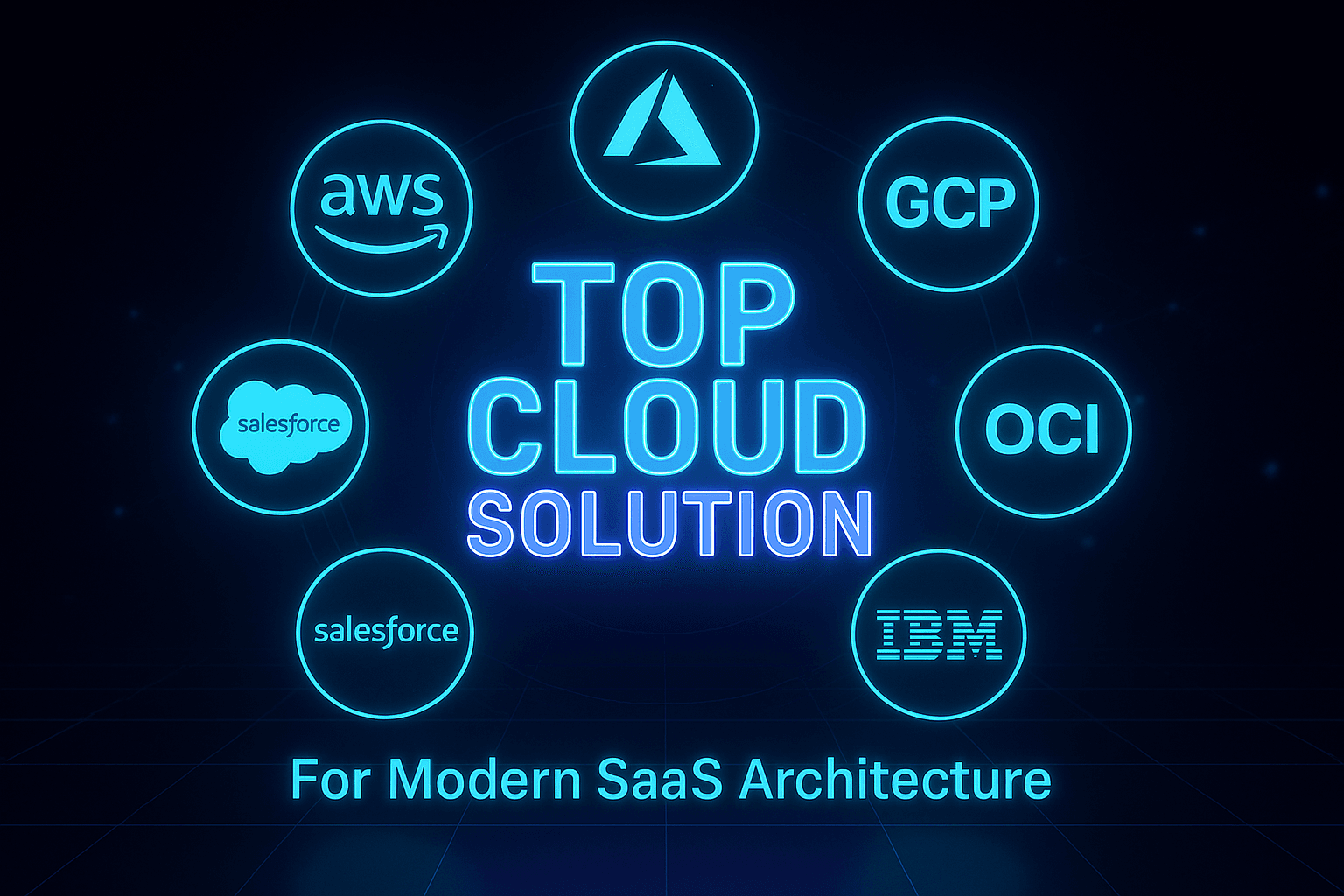
| Platform | Best For | Key Features | Starting Cost |
|---|---|---|---|
| AWS | Scalability, startups | Auto Scaling, Lambda, global reach | Pay-as-you-go |
| Azure | Enterprise integration | Hybrid support, strong .NET tools | Variable pricing |
| GCP | AI, data-heavy apps | BigQuery, Kubernetes expertise | Free trial available |
| Oracle Cloud | Database-centric workloads | Auto-scaling, cost-saving tools | Usage-based |
| IBM Cloud | Hybrid/multi-cloud setups | Cloud Paks, enterprise integration | Usage-based |
| Salesforce | CRM-focused solutions | Hyperforce, regional data hosting | Subscription-based |
Choosing the right platform depends on your business size, goals, and specific needs. Let’s dive deeper into what makes each platform unique.
Amazon Web Services (AWS) is a powerhouse in the world of cloud platforms, designed to meet the needs of modern SaaS architectures. With its infrastructure executing an astonishing one trillion Lambda functions every month, AWS exemplifies scalability and reliability.
Scalability and Performance
AWS shines when it comes to handling fluctuating demands. Features like Auto Scaling ensure resources are allocated optimally, leading to a reported 75% performance improvement during traffic surges. For instance, during Amazon Prime Day 2020, AWS CloudFront managed an impressive 280 million HTTP requests per minute, showcasing its ability to handle massive workloads without breaking a sweat.
Cost Optimization
AWS provides flexible pricing options to help businesses manage costs effectively while maintaining performance:
Real-world examples highlight these benefits: Alert Logic slashed cloud expenses by 28%, and Delhivery reduced infrastructure costs by 15% in just 50 days.
Security and Compliance
Security is at the core of AWS, with a range of integrated services offering robust protection:
| Security Layer | Key Services | Primary Function |
|---|---|---|
| Infrastructure Protection | AWS Shield, GuardDuty | Detect threats and defend against DDoS |
| Data Protection | KMS, Secrets Manager | Encrypt data and manage secure keys |
| Access Control | IAM, CloudTrail | Manage identities and log activity |
| Compliance Monitoring | AWS Config, Security Hub | Track compliance automatically |
AWS supports 143 security standards and compliance certifications, including major frameworks like HIPAA, GDPR, and SOC 2, making it a trusted choice for businesses with stringent regulatory needs.
Integration and Architecture
AWS offers tools and best practices to ensure seamless integration and efficient architecture:
Additionally, AWS Graviton-powered instances deliver 40% better price performance compared to x86 processors, making them a smart option for SaaS businesses seeking high performance at a lower cost.
Next, let’s explore another major cloud solution that’s helping to shape the future of SaaS architecture.

Microsoft Azure stands out as a powerful platform for building and scaling modern SaaS applications. With a presence in 60 Azure regions and a customer base exceeding 65,000 worldwide, it offers a mature ecosystem tailored to meet the demands of SaaS architecture.
Azure provides a range of compute options designed to handle diverse workloads, ensuring flexibility and scalability:
| Compute Service | Primary Use Case | Scaling Capability |
|---|---|---|
| Virtual Machine Scale Sets | Traditional Applications | Thousands of Linux/Windows VMs |
| Azure Kubernetes Service (AKS) | Containerized Apps | Managed Kubernetes orchestration |
| Azure Container Apps | Microservices | Serverless container scaling |
| Azure Functions | Event-driven Code | Automatic scaling based on demand |
For performance testing, Azure’s Load Testing service can simulate up to 100,000 virtual users across 400 engine instances in a single test run. This makes it easier to manage costs and optimize performance for even the most demanding applications.
Azure offers several tools and programs to help businesses control costs without sacrificing performance. Key options include:
These cost-saving measures are bolstered by Azure’s robust integration framework, making it a cost-effective choice for SaaS providers.
Azure’s Integration Services handle billions of actions and trillions of requests monthly, showcasing their strength in connecting various systems and processes. Key tools and their functions include:
These tools make it easier to integrate and streamline SaaS solutions, no matter the scale or complexity.
Microsoft has committed $20 billion to cybersecurity over five years, ensuring Azure remains a secure platform. Azure Monitor enhances this by collecting and analyzing data across multiple Azure and non-Azure subscriptions, providing comprehensive monitoring and insights.
According to a Forrester study, Azure Integration Services achieved a 295% ROI over three years. With more than 1,400 pre-built connectors and templates, many enhanced by AI, Azure enables rapid development and deployment of SaaS solutions while maintaining high levels of performance and reliability.
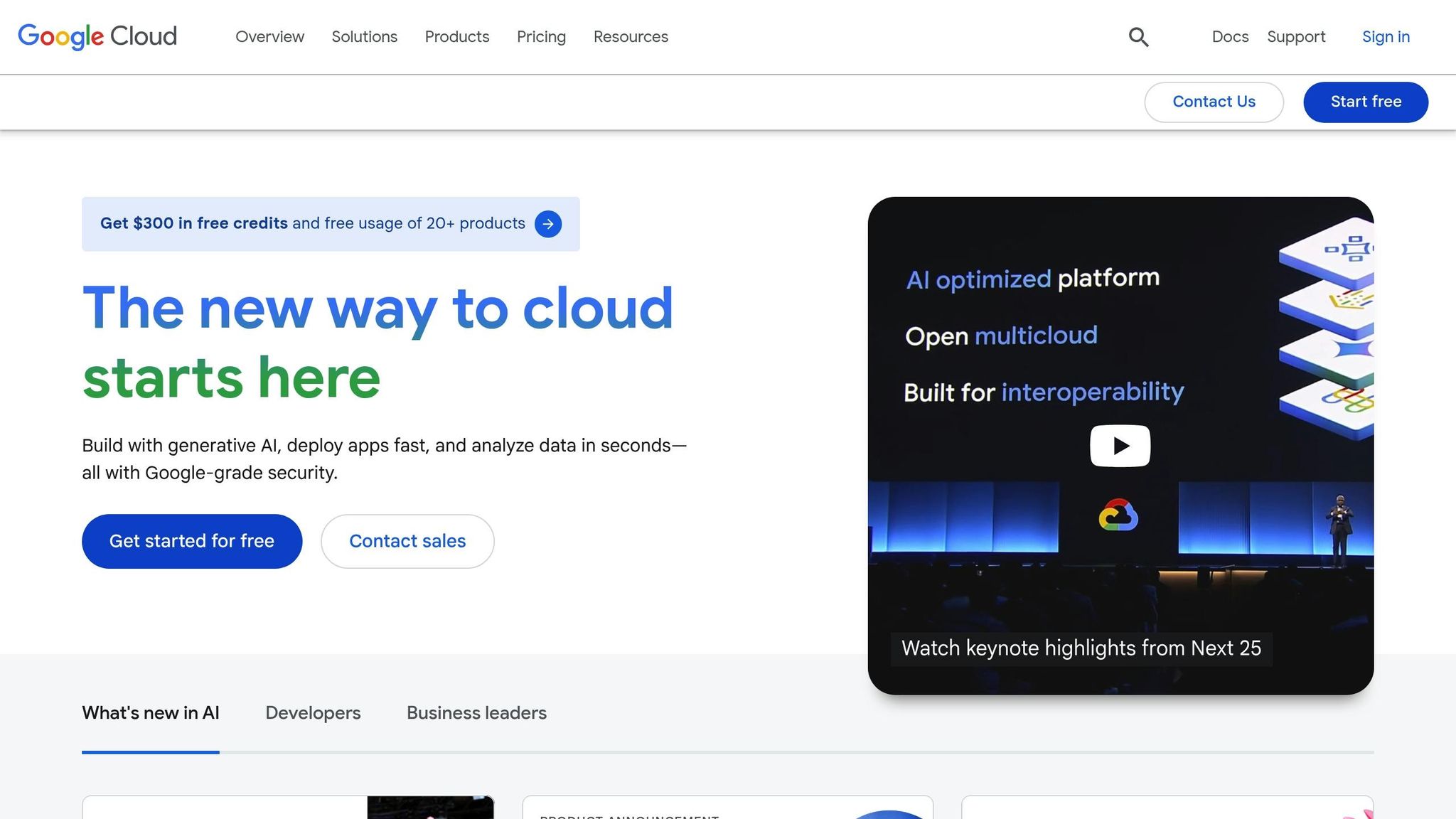
Google Cloud Platform (GCP) has become a key player in modern SaaS architecture. Its market share has grown significantly, jumping from 6% in 2017 to 11% in 2022. With a broad range of services and a strong infrastructure, GCP is particularly suited for building scalable, AI-powered solutions.
GCP's extensive global network of data centers ensures applications can be accessed worldwide. It offers a variety of compute options to cater to different needs:
| Service Type | Key Features | Best For |
|---|---|---|
| Google Kubernetes Engine | Automated container orchestration | Microservices architecture |
| Cloud Functions | Serverless computing | Event-driven applications |
| Compute Engine | VM instances with flexible pricing | Traditional workloads |
| Cloud Run | Fully managed containerized apps | Stateless applications |
GCP's pricing structure is designed to balance flexibility and affordability, offering several discount programs:
For instance, PlayPlay managed to cut its cloud costs by 40%, while Arabesque AI saw a 75% reduction in expenses.
GCP operates under a shared responsibility model for security. This approach ensures Google secures the infrastructure, while users handle application-level security and data protection. Key security features include:
"The Google Cloud Security Model operates under a shared responsibility framework where Google secures the infrastructure while users manage application-level security, configurations, and data protection." - GCP Masters
GCP shines in the realms of AI and analytics. Nearly 90% of generative AI unicorns are GCP customers. Its serverless data warehouse, BigQuery, can process petabytes of data at just $5 per terabyte, making it a cost-effective solution for ad-hoc queries and variable workloads. These advanced analytics tools help businesses achieve measurable results.
Companies using GCP often see significant cost savings and performance improvements. For example, Apxor, a zero-code app development company, reduced costs by 30% in 2025 while boosting performance by leveraging Compute Engine, Dataflow, and TensorFlow.
GCP meets stringent regulatory requirements, supporting major compliance frameworks:
| Standard | Implementation Resources |
|---|---|
| FedRAMP | Implementation guide, Three-Tier Workload setup |
| HIPAA | Healthcare data protection toolkit, Workload alignment guides |
| ISO 27001 | Comprehensive compliance documentation |
| PCI-DSS | Payment card industry security standards |
This strong compliance portfolio, combined with GCP's advanced features and competitive pricing, makes it a standout choice for SaaS businesses. Next, we’ll take a closer look at Oracle Cloud Infrastructure to continue our comparison.

Oracle Cloud Infrastructure (OCI) is a powerful platform designed to support modern SaaS architecture. It combines solutions for compute, storage, and networking into a cohesive system. With 50 interconnected commercial and government cloud regions, OCI provides the global reach needed for large-scale deployment requirements.
OCI's Gen 2 Cloud architecture is built for efficiency, offering features like auto-scaling and Kubernetes orchestration through its Container Engine. These tools help businesses manage workloads effectively:
| Component | Features | Benefits |
|---|---|---|
| Compute Services | Auto-scaling, flexible shapes | Optimizes resource usage |
| Container Engine | Kubernetes orchestration | Simplifies microservices deployment |
| Functions | Serverless computing | Supports event-driven workflows |
| Load Balancing | Global distribution | Ensures high availability |
OCI stands out for its competitive pricing and cost-saving capabilities. It can reduce storage costs by up to 70%, networking expenses by 80%, and compute costs by 50%. For example, Brazilian retailer Tok&Stok utilized OCI's monitoring tools to dynamically adjust compute capacity based on demand, eliminating unnecessary server costs.
Security is deeply integrated into OCI's architecture, offering a range of advanced features:
| Security Feature | Implementation Details |
|---|---|
| Network Virtualization | Isolated tenant environments unique to OCI |
| Hardware Root of Trust | Ensures physical security validation |
| Cloud Guard | Provides continuous security monitoring |
| Identity Management | Enables granular access controls |
Darling Ingredients improved their security posture by leveraging OCI's Cloud Guard for continuous monitoring.
OCI enhances performance with intelligent resource and storage management:
These capabilities make OCI a key player in supporting modern SaaS applications.
OCI's impact is evident in real-world use cases. Deutsche Bank, for example, cut its energy consumption by 50% by deploying Oracle Exadata Cloud@Customer. Meanwhile, a healthcare cooperative expanded its electronic medical records (EMR) system to 300 branches while reducing IT costs by 25%.
"Oracle believes security should be foundational and built-in, and customers shouldn't be forced to make tradeoffs between security and cost."
OCI's robust framework is complemented by adherence to strict compliance standards, including ISO 27001, SOC 1/2/3, HIPAA, and PCI DSS. This makes it ideal for industries with stringent regulatory requirements. For example, a telecommunications company successfully migrated 8,000 workloads to OCI, cutting customer service response times by 50%.
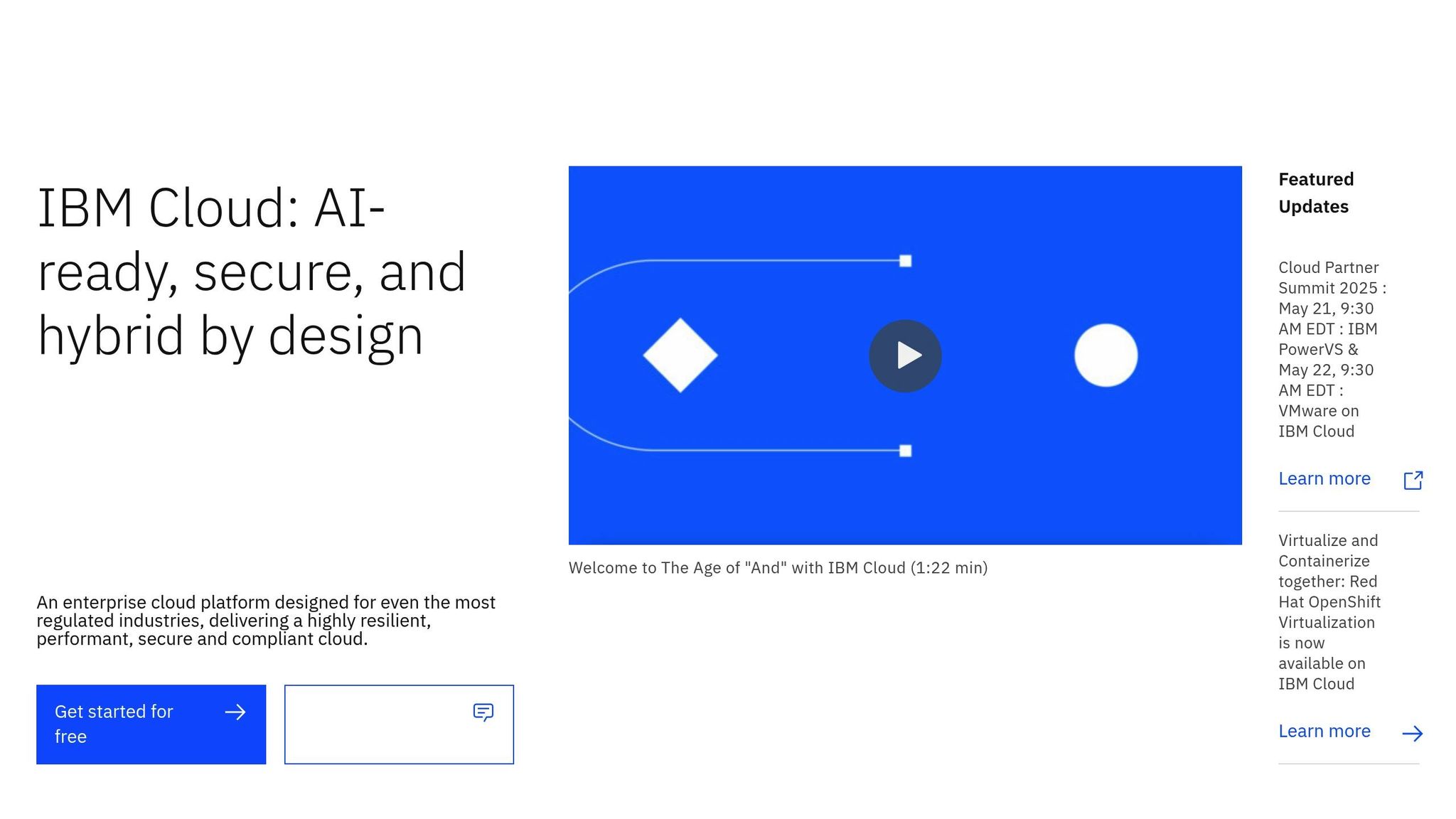
IBM Cloud provides a comprehensive range of IaaS, PaaS, and SaaS solutions designed to support modern SaaS architectures. With operations in 20 countries and a portfolio of 170 service offerings, IBM Cloud is a global player in cloud computing.
The platform stands out for its flexibility, supporting public, private, hybrid, and multi-cloud deployment models. Its container services offer key tools for businesses:
| Service Component | Key Features | Business Impact |
|---|---|---|
| Container Registry | Secure image storage, vulnerability scanning | Strengthened security and compliance |
| Orchestration Service | Automated deployment, scaling | Increased operational efficiency |
| Serverless Platform | Event-driven architecture | Lower infrastructure costs |
| Cloud Paks | Pre-integrated data and AI automation | Faster deployment times |
IBM Cloud prioritizes security with its Security Hub, which integrates tools like IBM Key Protect, Secrets Manager, and the Security and Compliance Center. The platform ensures data protection at every stage - whether at rest, in transit, or in use - through advanced tools like "keep your own key" systems and Hyper Protect Crypto Services. Its global infrastructure supports a high-speed network delivering over 2,600 Gbps between data centers and network nodes.
IBM Cloud offers flexible pricing models to help businesses manage costs effectively:
| Pricing Model | Description | Savings Potential |
|---|---|---|
| Pay-as-you-go | Default pricing for all services | Adjusts costs based on usage |
| Enterprise Savings Plans | Discounts for committed spending | Savings based on volume |
| Cloud Reservations | 1–3 year compute commitments | Reduces long-term costs |
IBM Cloud Pak for Integration (CP4I) simplifies enterprise connectivity with advanced B2B and file transfer features. Its API Connect service, which holds a 22% market share, offers full API lifecycle management across various cloud environments. These tools enhance IBM Cloud’s ability to create seamless SaaS ecosystems.
"Our partnership with IBM is centered on helping clients drive productivity and growth, especially through AI and automation."
– Matt Langione, Managing Director and Partner at Boston Consulting Group
For monitoring, IBM Cloud provides tools that cater to both application and infrastructure performance:
| Tool | Monthly Cost | Primary Function |
|---|---|---|
| Instana | $75 | Application performance monitoring |
| Cloud Monitoring | $37 | Tracks infrastructure and service metrics |
With over 2,500 cloud technology patents, IBM Cloud demonstrates its dedication to pushing boundaries. Its enterprise sovereign cloud capabilities address the requirements of heavily regulated industries. Additionally, automated posture management tools ensure consistent security across hybrid and multicloud setups. Next, we’ll take a closer look at Salesforce Cloud’s offerings.
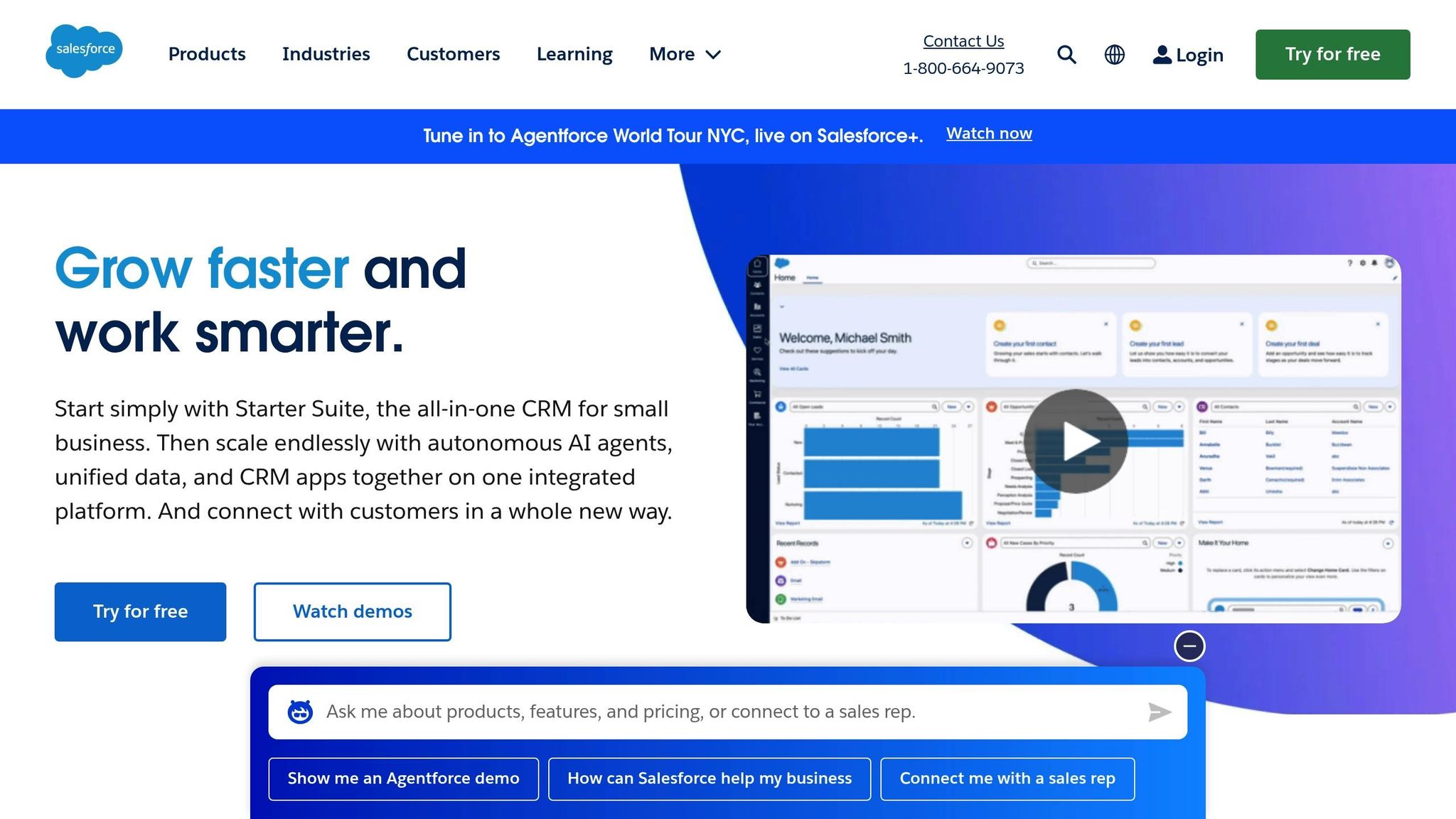
Salesforce Cloud stands out as a powerful example of how modern SaaS platforms can deliver performance, integration, and security. Its Hyperforce infrastructure allows businesses to deploy applications on leading public cloud providers, all while adhering to strict security and compliance standards.
Hyperforce is designed to deliver reliability and scalability. With a 99.95% uptime guarantee, it processes over 2 trillion AI results weekly and supports 85% multi-cloud adoption. Its elastic scalability is particularly useful for businesses that experience fluctuating demands. For instance, a global retail company leveraged Hyperforce to handle massive traffic spikes during the holiday shopping season seamlessly.
Salesforce's Data Cloud simplifies data management by unifying data without requiring complex pipelines. It offers native connectors for Amazon S3 and Google Cloud Storage, while zero-copy integration enables direct access to platforms like Snowflake and Data Bricks. Additionally, regional data hosting ensures compliance with local regulations, making it easier for businesses to meet governance requirements.
Salesforce Cloud provides flexible pricing options to cater to businesses of all sizes:
| Plan Type | Monthly Cost per User | Best Suited For |
|---|---|---|
| Starter Suite | $25 | Small businesses |
| Pro Suite | $100 | Mid-sized companies |
| Enterprise | $165 | Large organizations |
| Einstein 1 Sales | $500 | AI-driven operations |
In addition to competitive pricing, Salesforce Cloud is designed to seamlessly connect systems, making it a valuable tool for businesses aiming to streamline operations.
Salesforce Cloud offers a variety of integration options to suit different business needs:
| Integration Type | Features | Application |
|---|---|---|
| Native Integration | Direct platform connections | Core Salesforce services |
| AppExchange | 2,500+ pre-built apps | Extend platform functionality |
| Custom APIs | Secure data sharing | Tailored requirements |
| Middleware Solutions | Real-time data updates | Complex system integration |
These integration approaches make it easy for businesses to connect Salesforce with existing systems or expand its capabilities.
Hyperforce's adaptability is evident in its real-world applications. For example, a European pharmaceutical company uses Hyperforce in the AWS Frankfurt region to securely host sensitive patient data while meeting GDPR requirements. Similarly, a global manufacturing firm reported a 40% reduction in latency by deploying Salesforce Sales Cloud closer to its regional teams.
Security is a cornerstone of Salesforce Cloud. Its multi-layered security protocols, zero-trust architecture, and robust encryption have enabled 94% of businesses to strengthen their security measures and 91% to meet compliance standards more effectively. This focus on security and compliance ensures that businesses can operate with confidence, no matter their industry or location.
The tables below provide a snapshot of the key metrics across major cloud platforms, focusing on features, security, integration options, and cost management. These comparisons aim to help you evaluate the best fit for your SaaS needs.
| Platform | Starting Cost | Free Tier/Trial | Notable Features | Best For |
|---|---|---|---|---|
| AWS | Pay-as-you-go | Yes – popular services | Large service catalog, global reach | Large enterprises, startups |
| Microsoft Azure | Variable pricing | 30-day trial | Hybrid support, strong .NET integration | Enterprise Windows environments |
| Google Cloud | Variable pricing | Free trial available | Advanced AI/ML tools, Kubernetes expertise | Data-heavy applications |
| Oracle Cloud | Usage-based | $300 credit + free tier | Database performance optimization | Database-centric workloads |
| IBM Cloud | Usage-based | 40+ free services | Enterprise-grade integration, Watson AI | Traditional enterprises |
| Salesforce Cloud | Subscription-based | Limited trial | CRM-native tools, Hyperforce platform | CRM-focused solutions |
With 55% of SaaS users reporting unintentional data exposure, robust security measures and compliance are critical when choosing a cloud platform.
| Platform | Key Certifications | Data Privacy Features | Compliance Standards |
|---|---|---|---|
| AWS | SOC 1/2/3, ISO 27001 | Regional data centers, key management | HIPAA, GDPR, PCI DSS |
| Microsoft Azure | ISO 27001, SOC 2 | Azure Policy, Key Vault | HIPAA, GDPR |
| Google Cloud | ISO 27001, SOC 2/3 | Cloud KMS, VPC Service Controls | GDPR, CCPA |
| Oracle Cloud | SOC 1/2, ISO 27001 | Data Safe, Vault | HIPAA, PCI DSS |
| IBM Cloud | ISO 27001, SOC 2 | Hyper Protect Services | GDPR, HIPAA |
| Salesforce Cloud | ISO 27001, SOC 2 | Shield Platform Encryption | GDPR, CCPA |
For SaaS platforms, smooth integration with existing systems and third-party tools is a priority. Here's how the platforms stack up:
| Platform | API Management | Pre-built Connectors | Integration Tools |
|---|---|---|---|
| AWS | API Gateway | Services | AWS App Mesh |
| Microsoft Azure | API Management | Logic Apps | Azure Integration Services |
| Google Cloud | Apigee | Cloud Endpoints | Anthos |
| Oracle Cloud | API Platform | Integration Cloud | Service Bus |
| IBM Cloud | API Connect | App Connect | Cloud Pak |
| Salesforce Cloud | MuleSoft | AppExchange | Integration Cloud |
Keeping cloud expenses in check is another vital factor. Here's a breakdown of cost management tools across platforms:
| Platform | Cost Analysis Tools | Budget Controls | Resource Optimization |
|---|---|---|---|
| AWS | Cost Explorer | AWS Budgets | Savings Plans |
| Microsoft Azure | Cost Management | Budget Alerts | Reserved Instances |
| Google Cloud | Cost Management | Budget Controls | Committed Use Discounts |
| Oracle Cloud | Cost Analysis | Budget Tracking | Universal Credits |
| IBM Cloud | Usage Dashboard | Spending Limits | Reserved Instances |
| Salesforce Cloud | Resource Monitor | Usage Analytics | Platform Optimization |
These tables highlight the diverse strengths of each platform, from scalability and security to cost control and integration. By aligning these factors with your SaaS strategy, you can make an informed choice tailored to your specific needs.
Selecting the right cloud platform depends on your specific needs, growth plans, and operational scale. With cloud migration failure rates ranging from 44% to 57%, making an informed choice is crucial. Below, you'll find tailored advice for startups, enterprises, and specific industries to help guide your decision.
Startups and smaller organizations often need platforms that balance cost and functionality. Here’s what to look for:
Larger organizations have more complex requirements. Consider these factors:
These considerations align with earlier discussions on scalability and security, underscoring their importance for enterprise-level decisions.
Different industries often benefit from platforms tailored to their unique challenges. Here’s a quick breakdown:
| Industry | Recommended Platform | Key Benefits | Notable Example |
|---|---|---|---|
| Financial Services | AWS | Advanced security, global reach | Revolut reduced costs by 40% and improved fraud detection by 60% |
| Healthcare | Azure | HIPAA compliance, data analytics | NHS Digital cut reporting time by 80% |
| Media & Entertainment | GCP | AI/ML capabilities, content delivery | Spotify achieved 95% recommendation accuracy |
| Enterprise Software | Oracle Cloud | Database optimization, legacy system support | Ideal for database-heavy workloads |
While aligning with industry needs is critical, keeping costs under control is equally important.
Managing expenses effectively is vital for long-term success. Here’s how leading platforms help:
"Select providers with proven stability and strong financial backing"
These strategies can help ensure you get the most value from your cloud platform while staying aligned with your business goals.
Choosing the right cloud platform for your SaaS business begins with identifying what your business truly needs. Look at factors like scalability, security, compliance needs, and integration options. Can the platform handle spikes in usage? Does it support multi-tenancy? And most importantly, does it align with where you see your business heading in the long run?
Another key consideration is cost. Dive into the total cost of ownership - this means looking beyond the surface pricing models. Are there hidden fees lurking in the fine print? Make sure the costs fit your budget and won't derail your financial plans. Testing the platform through a trial or pilot program is a smart move to gauge its performance, reliability, and the quality of its customer support.
Finally, don't underestimate the value of feedback. Research what other users have to say and gather insights from reviews and case studies. The goal is to find a platform that not only checks the technical boxes but also has the capacity to support your business as it grows.
When assessing cloud solutions for security and compliance, there are a few key areas to prioritize. Start with the data protection measures. Look for features like encryption, reliable backup systems, and mechanisms to prevent data loss - these are vital for keeping your sensitive information safe and accessible.
Next, review the provider’s compliance certifications. Certifications such as GDPR, HIPAA, or PCI DSS indicate that the provider meets important regulatory standards, giving you confidence in their ability to handle your data responsibly.
Lastly, take the time to understand the shared responsibility model. This framework outlines which security responsibilities fall on the provider and which are yours. Knowing this division of tasks ensures there are no gaps in your security strategy.
By focusing on these elements, you’ll be better equipped to select a cloud solution that meets your organization’s security and compliance requirements.
To keep cloud costs in check within a SaaS architecture, it's crucial to stay on top of your cloud usage and billing data. Regular reviews can help you spot underused or idle resources that might be scaled down or eliminated, cutting unnecessary expenses. Setting clear budgets and leveraging automated monitoring tools can also help avoid unexpected charges and maintain control over your spending.
For predictable workloads, consider opting for reserved instances or spot instances, which often come with hefty discounts. When dealing with dynamic workloads, autoscaling can be a game-changer. It adjusts resources based on demand, ensuring you're not over-provisioning during periods of low activity. These approaches strike a balance between cost efficiency and maintaining the performance and scalability of your SaaS architecture, keeping it both reliable and economical.
Need an expert team to provide digital solutions for your business?
Book A Free CallDive into a wealth of knowledge with our unique articles and resources. Stay informed about the latest trends and best practices in the tech industry.
View All articlesGet in Touch
Let's Make It Happen
Get Your Free Quote Today!

Get in Touch
Let's Make It Happen
Get Your Free Quote Today!

